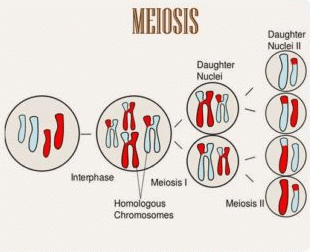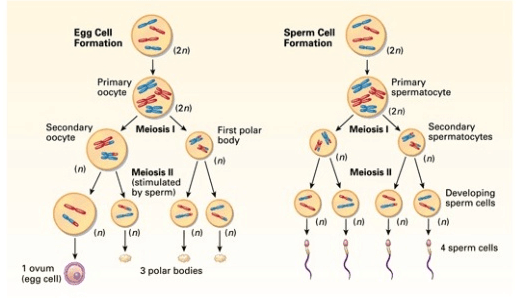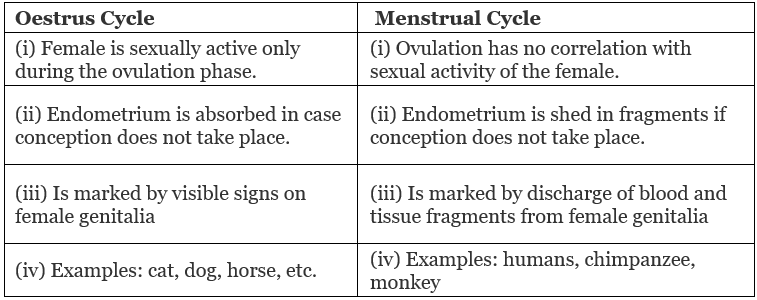NCERT Exemplar: Reproduction in Organisms - 2 (Old NCERT) - NEET PDF Download
SHORT ANSWER TYPE QUESTION
Q.1. In haploid organisms that undergo sexual reproduction, name the stage in the life cycle when meiosis occurs. Give reasons for your answer.
Ans. In haploid organisms that undergo sexual reproduction, gametes are usually formes by meiotic division and chromosome numbers is reduced to half of the total. The stage in the life cycle when meiosis occurs is called sporophytic generation and is represented by one celled zygote. In such plants, the dominant phase is gametophytic phase which is haploid.
This kind of life cycle is called haplontic. Volvox, Spirogyra and some species of Chlamydomonas shows this type of life cycle.
Q.2. The number of taxa exhibiting asexual reproduction is drastically reduced in higher plants (angiosperms) and higher animals (vertebrates) as compared with lower groups of plants and animals. Analyse the possible reasons for this situation.
Ans. Asexual reproduction involves mitosis. In organisms with complex level of organization, mitosis alone cannot produce all kinds of differentiation which is required for making various types of tissue. Due to this, asexual reproduction is frequently seen in lower groups of plants and animals which show simple level of organization. But incidence of asexual reproduction drastically reduces as go higher in terms of complexity of body design.
Q.3. Honeybees produce their young ones only by sexual reproduction. Inspite of this, in a colony of bees we find both haploid and diploid individuals. Name the haploid and diploid individuals in the colony and analyse the reasons behind their formation.
Ans. In a colony of bees, the females and workers are diploid while the male drones are haploid. The male drones are developed from unfertilized eggs. Development of an individual from unfertilized eggs is called parthenogenesis. This phenomenon is also seen in many plants, e.g. banana. In that case, the fruit is called parthenocarpic fruit.
Q.4. With which type of reproduction do we associate the reduction division? Analyse the reasons for it.
Ans. Reduction division is associated with sexual reproduction. We know that fertilization is an important step in sexual reproduction. Since fertilization involves fusion of two gametes, the number or chromosomes becomes diploid in zygote. To ensure continuity of characters in a species, it is necessary to develop some mechanism by which number of chromosomes can be haploid in the gametes. Hence, gametogenesis involves reduction division and thus gametes have haploid number of chromosomes.
Q.5. Is it possible to consider vegetative propagation observed in certain plants like Bryophyllum, water hyacinth, ginger etc., as a type of asexual reproduction? Give two/three reasons.
Ans. Vegetative propagation in certain plants; like Bryophyllum, water hyacinth, ginger, etc. can be termed as asexual reproduction. Following are some to the reasons for this:
(a) Reproduction involves a single parent
(b) Meiosis does not happen during any stage of reproduction
(c) Offspring get the set of DNA from a single parent
Q.6. 'Fertilisation is not an obligatory event for fruit production in certains plants'. Explain the statement.
Ans. Many plants have an inbuilt ability to produce fruits without fertilisation. Fruits produced in that way are called parthenocarpic fruit. Banana is a very good example of parthenocarpic fruit. Many other fruits are produced by artificially inducing parthenocarpy in plants, e.g. papaya and watermelon. Such plants do not produce seeds because sees cannot be produced without fertilization. Hence, it can be said that fertilization is not mandatory for fruit production in certain plants.
Q.7. In a developing embryo, analyse the consequences if cell divisions are not followed by cell differentiation.
Ans. During development of an embryo, cell differentiation is necessary to produce different kinds of tissues which could later develop various organs and organ system. If cell differentiation does not happen, then different tissues would not be produced and the embryo would only develop into a mass of identical cells; unable to develop into a new individual. This can be compared with differentiation of meristematic cell in plants. In vascular plants, it is differentiation which ultimately results in formation of specialized tissues which performs various functions.
Q.8. List the changes observed in an angiosperm flower subsequent to pollination and fertilisation.
Ans. Following changes take place in an angiosperm flower after pollination and fertilization
(a) Sepals, petals and stamens wither and fall off
(b) Zygote develops into the embryo and ovule develops into the seed
(c) Ovary develops into fruit
(d) Fruit develops a thick outer covering; called pericarp.
Q.9. Suggest a possible explanation why the seeds in a pea pod are arranged in a row, whereas those in tomato are scattered in the juicy pulp.
Ans. In a pea pod, the pericarp is not differentiated into many layers. In a tomato fruit, the pericarp is differentiated into epicarp, mesocarp and endocarp. Most of the edible part or tomato is composed of mesocarp which is juicy and fleshy. Moreover, placentation is responsible for arrangement of seeds in a fruit. A pea flower shows marginal placentation, while a tomato shows axial placentation.
Q.10. Draw the sketches of a zoospore and a conidium. Mention two dissimilarities between them and atleast one feature common to both structures.
Ans. Difference
Similarities
(i) Both are involved in asexual reproduction.
(ii) Both help the organism to tide over the bad phase.
Q.11. Justify the statement ‘Vegetative reproduction is also a type of asexual reproduction’.
Ans. It is true that vegetative reproduction is also a type of asexual reproduction. In vegetative reproduction, a single parent is involved. There is no gamete formation.
Reduction division never takes place during vegetative propagation. Offspring; produced after vegetative propagation are clones of their parent. These features justify that vegetative reproduction is a type of asexual reproduction
LONG ANSWER TYPE QUESTIONS
Q.1. Enumerate the differences between asexual and sexual reproduction. Describe the types of asexual reproduction exhibited by unicellular organisms.
Ans.
Type of Asexual Reproduction in Unicellular Organisms:
A. Binary Fission: In this case, the unicellular organism undergoes cell division and two daughter cells are produced. The parent generation ceases to exist after binary fission.
Example: Amoeba.
B. Multiple Fission: In this case, the nucleus of the mother cell divides into multiple nuclei.
A cyst develops around the mother cell. The cyst helps the mother cell to tide over unfavourable circumstances. On resumption of favourable circumstances, the cyst disintegrates and daughter nuclei develop into new individuals.
Example: Plasmodium, Entamoeba
C. Budding: In this case, a bud develops at one end of the cell. The nucleus produces a daughter nucleus which then goes to the bud. The bud then gets detached from the mother cell and develops into a new individual.
Example: yeast
Q.2. Do all the gametes formed from a parent organism have the same genetic composition (identical DNA copies of the parental genome)? Analyse the situation with the background of gametogenesis and provide or give suitable explanation.
Ans. Fig: Gamete formationGamete formation happens after meiosis. During the pachytene stage of Prophase I in meiosis, crossing over takes place. Crossing over is an important steps of meiotic cell division. Non-sister chromatids combine during crossing over. This leads to recombination of various genes.
Fig: Gamete formationGamete formation happens after meiosis. During the pachytene stage of Prophase I in meiosis, crossing over takes place. Crossing over is an important steps of meiotic cell division. Non-sister chromatids combine during crossing over. This leads to recombination of various genes.
Thus, the daughter cells produced after meiosis have slightly different genotype compared to the mother cell. In fact, crossing over is responsible for bringing variations in subsequent generations. We know the evolution becomes possible because of accumulation of minor variations over thousands of generations.
In the context of above facts about meiosis, it is clear that the gametes do not have the same genetic composition as the parental genome.
Q.3. Although sexual reproduction is a long drawn, energy-intensive complex form of reproduction, many groups of organisms in Kingdom Animalia and Plantae prefer this mode of reproduction. Give at least three reasons for this.
Ans. Sexual reproduction gives various survival benefits and hence higher organisms in Kingdom Animalia and Plantae prefer this mode of reproduction.
Asexual reproduction is a fast process through which a large number of offspring can be produced in shorter time span. However, since offspring are clones of their parents hence they have same shortcomings as their parents. They will be equally susceptible to diseases and various other stresses as their parents. But offspring; produced after sexual reproduction have better genotype because it is a combination of genotype of two individuals.
Sexual reproduction helps an organism to easily tide over a bad phase. Many plants utilize asexual reproduction as a preferred mode when the conditions are favourable; like plenty of food, water and sunlight. But under unfavourable conditions, they resort to sexual reproduction.
Asexual reproduction can only depend on mutation for bringing evolution, while sexual reproduction can easily bank on variation for bringing evolution.
Q.4. Differentiate between
(a) Oestrus and menstrual cycles;
(b) Ovipary and vivipary. Cite an example for each type.
Ans.

Q.5. Rose plants produce large, attractive bisexual flowers but they seldom produce fruits. On the other hand a tomato plant produces plenty of fruits though they have small flowers. Analyse the reasons for failure of fruit formation in rose.
Both these plants - rose and tomato - both selected by human beings for different characteristics, the rose for its flower and tomato for its fruit.
Roses, being vegetatively propagated do not need to produce seeds.
Ans. Production of fruits or absence of fruits in these plants is result of human intervention through horticulture. To understand this issue, we first need to keep in mind the specific purpose for which a particular plant growth by humans.
Rose plants are mainly grown for ornamental purpose. Rose flowers are considered to be epitome of beauty. Additionally, most varieties of rose produce nice fragrance which further adds to its value. Seeds or fruits are not important for rose plants. Rose is grown by the horticulturists worldwide through vegetative propagation. Usually, a portion of the stem is cut off and is put in the soil to produce a new plant. Sometimes, the stem is peeled off at a small section and clay is applied to produce a new plantlet. Since producing a plant through vegetative propagation requires less time, so it is much beneficial for growing ornamental plants.
- Rose is a natural seed bearing plant but in domestically grown varieties, the petals are so tightly fit that they may do not permit pollination and hence fruits do not develop in these plants.
- Rose plants may not produce viable cell or functional egg.
- Rose plants may have abortive ovule.
- They may be self-incompatible There may be internal barriers for pollen tube growth and/or fertilization
Tomato, on the other hand, is produced for its juicy fruits. Hence, cultivators have to follow a method which enables them to get as many fruits as possible.
In both the cases, the number or size of flowers on a particular plant is not the deciding factor. But the purposes for which a particular plant is grown is the main deciding factor whether a plant produces a fruit or not.
FAQs on NCERT Exemplar: Reproduction in Organisms - 2 (Old NCERT) - NEET
| 1. What is reproduction in organisms? |  |
| 2. What are the different modes of reproduction in organisms? |  |
| 3. What are the advantages and disadvantages of asexual reproduction? |  |
| 4. How does sexual reproduction contribute to genetic variation? |  |
| 5. What are the different types of sexual reproduction in organisms? |  |



















